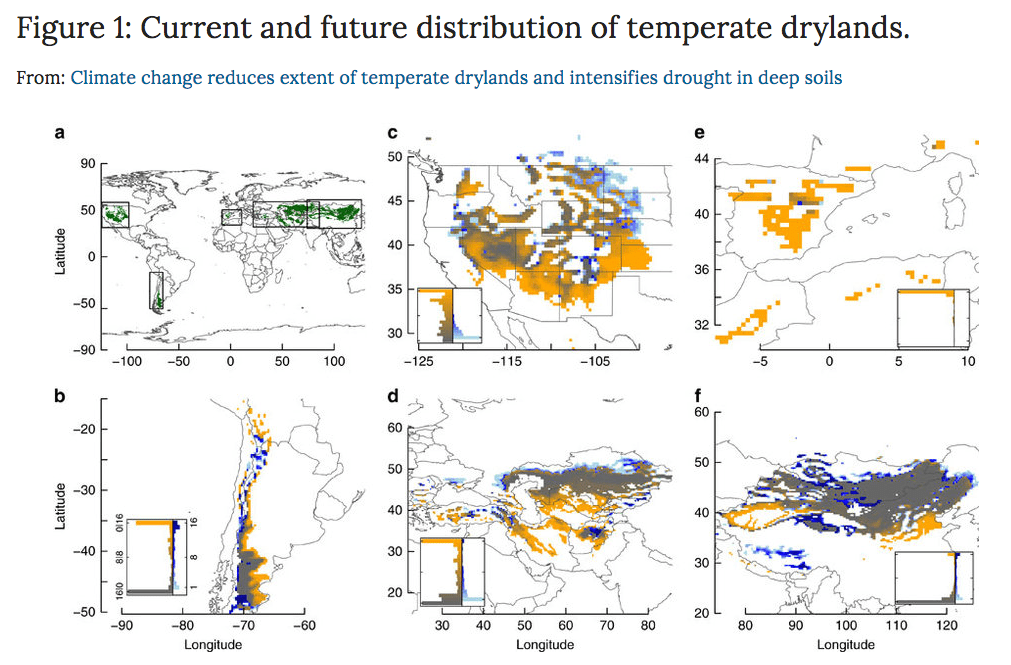PROJECTED global warming will likely decrease the extent of temperate drylands by a third over the remainder of the 21st century coupled with an increase in dry deep soil conditions during agricultural growing season.
These results have been presented in Nature Communications by an international collaboration led by the US Geological Survey and members from seven countries, including Scott Wilson at the Climate Impacts Research Centre (CIRC) at Umeå University in Sweden.
“I was impressed by the scope of the computer model: with many components of the water cycle calculated daily for 30 years, at 20,000 sites. All of this to simulate the current climate as well as 16 possible future climates. The variety of possible future climates gave pretty consistent outcomes, lending credibility to the results,” says Professor Scott Wilson, visiting researcher at Umeå University and researcher within CIRC.
Dryland habitats expanded by 4-8pc in the 20th century and now cover 40pc of the global terrestrial surface. As the global climate warms this expansion will likely continue. Forecasting the changes in precipitation and soil moisture for tropical and subtropical regions as a result of global warming is well constrained due to soil moisture patterns being closely linked to Hadley Circulations.

(a) Five temperate dryland regions with their current extent for 1980–2010 (green): (b) South America; (c) North America; (d) Western and Central Asia; (e) Mediterranean Basin; (f) Eastern Asia. (b–f) Future projected change in extent under RCP8.5 for 2070–2100, depicted as stable (grey), contracting (orange; no longer temperate dryland in 2070–2100), and expanding (blue; newly temperate dryland in 2070–2100) zones. Inset vertical histograms for b–f illustrate areal abundance in each category of GCM agreement about expansion or contraction of temperate drylands. Left (grey-orange) histogram depicts GCM agreement (that is, number of GCMs that agree in the direction of change) about the fate of current temperate drylands and shows the number of cells within each category ranging from pure grey (all 16 GCMs forecast stable temperate drylands) to pure orange (all GCMs forecast conversion from temperate dryland to non-temperate and/or non-dryland). Right (light blue—dark blue) histogram indicates GCM agreement of temperate dryland expansion into new areas and shows the number of cells within each category ranging from dark blue (all GCMs forecast conversion to temperate dryland) to light blue (one GCM forecasts conversion).
However, until recently, much uncertainty still existed concerning temperate drylands. The certainty of the forecasts is particularly important as warming leads to shifts from temperate to subtropical drylands, which leads to changes in precipitation and soil moisture, which in turn has profound effects on ecological services, provided to humanity, including the viability of certain temperate agricultural systems.
This uncertainty is changing because of improved supercomputer modelling of the movement of water through ecosystems, based on 20,000 locations around the world.
The results suggest that climate change will convert much of the area currently occupied by temperate grasslands and deserts to subtropical vegetation with effects on associated wildlife and human populations.
Specifically, these results predict a loss of 15 to 30pc of temperate grasslands by the end of the century with a substantial increase in deep soil drought conditions. The impacts can have large consequences for humanity.
“For example, with the expansion of subtropical drylands as temperate drylands warm cool season crops such as wheat and potato would no longer be economically viable,” says Scott Wilson. “Further, these subtropical drylands are home to aggressive diseases such as dengue and schistosomiasis. Given the predicted changes to dryland habitats globally, the outcome of this research is essential for developing strategies for adaptation by policy makers.”
Source: Climate Impacts Research Centre. Full article click here

HAVE YOUR SAY